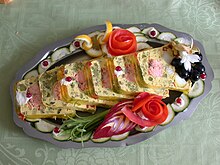
A terrine (French pronunciation: [tɛ.ʁin]), in traditional French cuisine, is a loaf of forcemeat or aspic, similar to a pâté, that is cooked in a covered pottery mold (also called a terrine) in a bain-marie.[1][2][3] Modern terrines do not necessarily contain meat or animal fat, but still contain meat-like textures and fat substitutes, such as mushrooms and pureed fruits or vegetables high in pectin.[4] They may also be cooked in a wide variety of non-pottery terrine moulds, such as stainless steel, aluminium, enameled cast iron, and ovenproof plastic.[5]
Terrines are usually served cold[6] or at room temperature. Most terrines contain a large amount of fat, although it is often not the main ingredient, and pork; many terrines are made with typical game meat, such as pheasant and hare.[7] In the past, terrines were under the province of professional charcutiers, along with sausages, pâtés, galantines, and confit.[8] Less commonly, a terrine may be another food cooked or served in the cooking dish called a 'terrine'.[6]
See also[edit]
References[edit]
- ^ Trésor de la langue française, s.v.
- ^ Oxford English Dictionary, s.v.
- ^ The Culinary Institute of America (CIA). (2012). Garde Manger: The Art and Craft of the Cold Kitchen, 4E (p. 678). Hoboken, NJ: John Wiley & Sons, Inc.
- ^ The Culinary Institute of America (CIA). (2012). Garde Manger: The Art and Craft of the Cold Kitchen, 4E (p. 300). Hoboken, NJ: John Wiley & Sons, Inc.
- ^ Bolat, Jeff. "Food saving expert". Retrieved 26 November 2022.
- ^ a b "Terrine". Dictionary.com. Retrieved March 21, 2017.
- ^ S. Beaty - Pownall (1902). The "Queen" Cookery Books No. 5 - Meats and Game. London: Horace Cox. pp. 225–229. Retrieved 16 August 2017.
- ^ The Culinary Institute of America (CIA). (2012). Garde Manger: The Art and Craft of the Cold Kitchen, 4E (p. xiii). Hoboken, NJ: John Wiley & Sons, Inc.
Well, that’s interesting to know that Psilotum nudum are known as whisk ferns. Psilotum nudum is the commoner species of the two. While the P. flaccidum is a rare species and is found in the tropical islands. Both the species are usually epiphytic in habit and grow upon tree ferns. These species may also be terrestrial and grow in humus or in the crevices of the rocks.
View the detailed Guide of Psilotum nudum: Detailed Study Of Psilotum Nudum (Whisk Fern), Classification, Anatomy, Reproduction